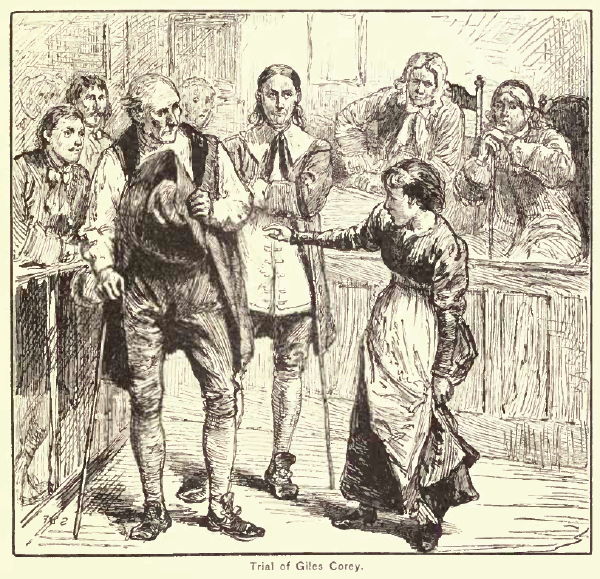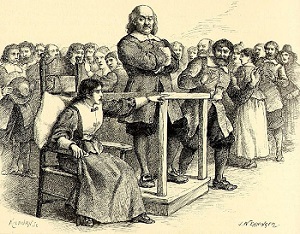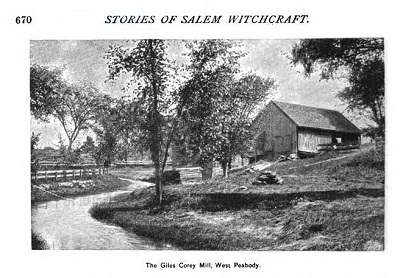Giles Corey was a successful farmer from Salem village who was accused of witchcraft during the Salem Witch Trials of 1692.
Born in Northampton, England, in 1621, Corey immigrated to the Massachusetts Bay Colony sometime after he married his first wife, Margaret.
Giles Corey’s Early Life:
Corey first lived in Salem town but then moved to Salem Village in 1659 and became a farmer. His wife died shortly after and he married a London immigrant, Mary Brite, on April 11, 1664. After Mary died in 1684, Corey married a widow named Martha Panon in 1690.
Corey was considered by many to be a violent man after he was charged with beating his farmhand, Jacob Goodale, to death with a stick in 1676. He stood trial, during which John Proctor testified that he heard Corey admit he had beaten Goodale, but in the end Corey was only fined for his actions.
Many locals, especially Thomas Putnam, suspected Corey had paid money to win his freedom. This death forever tainted Corey’s reputation in Salem and later came back to haunt him during his witchcraft trial.
Giles Corey & the Salem Witch Trials:
When the Salem Witch Trials began, Giles and Martha Corey were some of the first people to attend the pre-trial examinations at the Salem Village Meetinghouse.
As the examinations went on, Martha began to doubt their validity and even tried to persuade Giles from attending further examinations by hiding his riding saddle. These actions made Martha Corey seem suspicious and by mid-March, rumors began to swirl that Martha was a witch.

The Corey’s troubles officially began on Monday, March 21, 1692, when Martha Corey was arrested on charges of witchcraft.
Corey was so swept up in the mass hysteria he reportedly believed the accusations against his wife and even testified against her on March 24.
During his testimony against Martha, he spoke of the sudden illness of his ox and pet cat and described how his wife would stay up late at night and kneel by the fireplace as if in prayer but he never heard her recite any prayers.
Then, on April 18, 1692, an arrest warrant was issued for Giles Corey after Ann Putnam, Jr, Mercy Lewis, Abigail Williams, Mary Walcott and Elizabeth Hubbard accused him of practicing witchcraft against them.
After Corey was arrested and brought in for his examination, it seems he had changed his mind about the witch trials.
During Corey’s examination at the Salem Village Meetinghouse on April 19, Judge John Hathorne and Judge Jonathan Corwin repeatedly accused him of lying and even tied his hands to prevent him from practicing witchcraft in the courtroom, according to court records written by Reverend Samuel Parris:
All the afflicted were seized now with fits, and troubled with pinches. Then the court ordered his hands to be tied.
Magistrate: What, is it not enough to act witchcraft at other times, but must you do it now in the face of authority?
Corey: I am a poor creature, and cannot help it.
Upon the motion of his head again, they had their heads and necks afflicted.
Magistrate: Why do you tell such wicked lies against witnesses, that heard you speak after this manner, this very morning?
Corey: I never saw any thing but a black hog.
After untying one his hands, the afflicted girls began having fits, according to Parris’ records:
One of his hands was let go, and several were afflicted.
He held his head on one side, and then the heads of several of the afflicted were held on one side. He drew in his cheeks, and the cheeks of some of the afflicted were sucked in.
The court brought up Corey’s previous testimony against his wife and tried to get him to provide more incriminating information but this time Corey refused, according to the book The Salem Witch Trials: A Day-by-Day Chronicle of a Community Under Siege:
“The magistrates produced the testimony that Giles had given about his wife on the day of Rebecca Nurse’s examination, and asked about the time he was stopped in prayer.
‘What stopped you?’
‘I cannot tell. My wife came towards me and found fault with me for saying ‘living to God and dying to sin’ (The Gospel woman had presumably corrected a quotation from the Westminster Catechism, where God’s grace enables its recipient ‘to die unto sin, and live unto righteousness.’)
‘What was it frightened you in the barn?’
‘I know nothing that frightened me there.’
‘Why, here are three witnesses that heard you say so today.’
‘I do not remember it.’
Thomas Gould testified that Corey said ‘he knew enough against his wife to do her business,’ and the court wanted to know just what that knowledge was.
‘Why, that of living to God and dying to sin,’ said Corey.
Marshal George Herrick and Bibber’s daughter corroborated Gould’s claim, but Corey snapped, ‘I have said what I can say to that.’
‘What was that about your ox?’ asked the court, referring to the deposition about the lame ox.
‘I thought he was hipped.’
‘What ointment was that your wife had when she was seized? You said it was ointment she made by Major Gedney’s direction.’ Corey denied this and said it came from Goody Bibber.”
Although Corey had initially believed in the witch trials and willingly participated, even against his own wife, it became apparent during his examination he was no longer willing to do so.
In fact, Corey was so resistant to participate in the witch trials, his own trial never moved forward and he was never convicted because he died while being tortured by Sheriff Corwin that September.
The torture was the result of his refusal to continue with his trial. Although Corey plead “not guilty” when his case went to trial in September, he had taken advantage of a widely used legal tactic known as “standing mute” when he was asked the customary question of whether he would accept a trial by a jury of his peers.
English law at the time ordered any prisoner who stood mute to be tortured in an attempt to force a prisoner to talk, a tactic known as “peine forte et dure” which translates to “strong and harsh punishment.”
The exact torture procedure consisted of stripping the prisoner naked, laying him on the ground and placing a board with heavy stones on top of him. The weight was slowly increased over the course of several days until the prisoner yielded.

The idea to torture Corey may also been inspired by a letter Thomas Putnam sent to Judge Samuel Sewall reminding him of the murder Corey was involved in years before:
“The last night my daughter Ann was grievously tormented by witches, threatning that she should be pressed to death, before Giles Cory. But thro’ the goodness of a gracious God, she had at last a little respite. Whereupon there appeared unto her (she said) a man in a winding sheet; who told her that Giles Cory had murdered him, by pressing him to death with his feet; but that the Devil there appeared unto him, and covenanted with him, and promised him, He should not be hanged. The apparition said, God hardened his heart, that he should not hearken to the advice of the court, and so die an easy death; because as it said, “It must be done to him as he has done to me.” The apparition also said, That Giles Cory was carried to the court for this, and that the jury had found the murder, and that her father knew the man, and the thing was done before she was born. Now Sir, this is not a little strange to us; that no body should remember these things, all the while that Giles Cory was in prison, and so often before the court. For all people now remember very well, (and the records of the court also mention it,) That about seventeen years ago, Giles Cory kept a man in his house, that was almost a natural fool: which man died suddenly. A jury was impannel’d upon him, among whom was Dr. Zorobbabel Endicot; who found the man bruised to death, and having clodders of blood about his heart. The Jury, whereof several are yet alive, brought in the man murdered; but as if some enchantment had hindred the prosecution of the matter, the court proceeded not against Giles Cory, tho’ it cost him a great deal of money to get off.”
Knowing he would probably die anyway, if not in jail then on the gallows, many historians believe Corey refused to continue with his trial because was determined to avoid a conviction before his death so his estate would pass down to his grown children instead of being claimed by local authorities.
Yet, according to the book The Salem Witch Trials: A Reference Guide, Corey had already taken precautions to block local authorities from seizing his land:
“There is a widely circulated belief that Giles Corey refused to cooperate with the court specifically to ensure that his substantial estate would not be confiscated by the court. In actuality, it appears that his course of action only guaranteed that he would never have the stigma of a guilty verdict attached to his name, since his case would never be tried in a court of law. However, he wisely took the preliminary precaution to deed all his land into the possession of his sons-in-law, William Cheeves and John Moulton, in the event that Sheriff Corwin attempted to seize the Corey estate illegally, as he had done with the property of several other victims.”
Although “peine forte et dure” had never been used in the colonies before, according to Charles Wentworth Upham’s book Salem Witchcraft, published in 1867, Sheriff Corwin used this method to torture Giles Corey in an empty field on Howard Street, next to the Salem jail where Corey was being kept, for two or three days in September of 1692:
“It is said that Corey urged the executioners to increase the weight which was crushing him, that he told them it was of no use to expect him to yield, that there could be but one way of ending the matter, and that they might as well pile on the rocks. Calef says, that, as his body yielded to the pressure, his tongue protruded from his mouth, and an official forced it back with his cane. Some persons now living remember a popular superstition, lingering in the minds of some of the more ignorant class, that Corey’s ghost haunted the grounds where his barbarous deed was done; and that boys, as they sported in the vicinity, were in the habit of singing a ditty beginning thus: ‘More weight! More weight! Giles Corey cried!’”

During his torture, on September 18, Giles Corey was excommunicated from the church on equivocal grounds. The church documents argued that he was either guilty of witchcraft or of suicide due to his choice to endure lethal torture rather than enter a plea.
Either way he was considered a sinner and was cast out of the church, just as his wife had been a week earlier on September 11, 1692. (Giles Corey’s excommunication was later rescinded in 1712 and Martha’s was rescinded in 1703.)
After being tortured for days, Corey finally died on September 19, 1692. Due to the gruesome and very public nature of Corey’s protest, it is said to have caused many Salem residents at the time to rethink the witch trials, according to the book A Historical Sketch of Salem: 1626-1879:
“This man [Giles Corey] was eighty-one years old; and the barbarous death penalty inflicted on him by the officers of the law, tended to awaken the people to a realization of the grave responsibility resting on them as a Christian community. Doubts began to be felt in the public mind as to the justice of the prosecutions, and the inevitable sentence, and execution.”
Many historians consider his death an act of protest, according to the book Witchcraft at Salem:
“…because he would not agree to be tried by the Special Court of Oyer and Terminer. His death was a protest – the most dramatic protest of all – against the methods of the court.”
According to court records, it appears that despite Corey’s efforts to protect his assets, after his death, Sheriff George Corwin attempted to extort the Corey family for money by threatening to seize the Corey estate if they didn’t pay him. The following is an excerpt from a statement Corey’s son-in-law, John Moulton, submitted to the court in 1710 while seeking damages for Martha and Giles’ imprisonment and deaths:
“And as we cannot sufficiently express our grief for the loss of our father and mother in such away — so we cannot compute our expenses and cost but shall commit to your wisdom to judge of but after our father’s death the sheriff threatened to seize our father’s estate and for fear thar of we complied with him and paid him eleven pound six shillings in money by all which we have been greatly damnified & impoverished by being exposed to sell creatures [farm animals] and other things for little more than half the worth of them, to get the money to pay as aforesaid and to maintain our father & mother in prison but that which is grievous to us is that we are not only impoverished but also reproached and so may be to all generations and that wrongfully two unless something be done for the remove all thereof all which we humbly commit to the honorable court praying God to direct to that which may be acceptable in his sight and for the good of this land.”
In 1711, the Massachusetts legislature passed a bill clearing some of the names of the accused witches, including Giles and Martha Corey, and paid restitution for their imprisonment and deaths.
It has long been rumored that Corey placed a curse on Salem and its sheriff during his torture by shouting “Damn you! I curse you and Salem!” at the sheriff before he died.
Four years after Corey’s death, Sheriff Corwin died suddenly of a heart attack at just 30 years old. Local legend suggests that Corey not only cursed Corwin but every Salem sheriff since 1692.

In 1981, after Essex County Sheriff Robert E. Cahill was forced to retire early due to a stroke, heart attack and rare blood condition, he looked into the history of the sheriff’s office, as described in the book Cursed in New England:
“About 300 years later, in 1978, Robert Cahill – while in office – suffered a rare blood disease, a heart attack and a stroke. Doctors could not find the cause of his afflictions. He was forced to retire as sheriff of Essex County and as Master and Keeper of the jail. Today he lives in Florida. Mr. Cahill notes that the sheriff before him also contracted a serious blood ailment while in office; it forced him to retire. He, in turn, had inherited the post from his father after the elder man died of a heart attack…while serving as sheriff. The previous sheriff had suffered heart problems as well. ‘So have all the others, as far back as I could trace,’ he says. ‘And the two men who have followed me have had an awful lot of [legal] trouble.’”
Cahill believes that when the sheriff’s office was moved from Salem to the new prison in Middleton in 1991, it broke the curse and spared the future sheriffs. Since the move, no sheriffs have been diagnosed with any heart conditions or blood ailments.
Locals also believe Corey’s ghost still haunts the area around the Howard Street Cemetery, as it is now known, and that his ghost is often seen before and after a terrible event happens in the town.

One such occasion happened shortly before the Great Salem Fire of 1914 when witnesses saw a ghostly figure of an old man floating through the cemetery. The fire actually started near the area of Gallows hill and Proctor’s Ledge, where Corey’s wife, Martha, and 18 other people were hanged for witchcraft, before it spread and destroyed much of the town.
In 1953, Giles Corey was featured as a major character in Arthur Miller’s play The Crucible, in which he is depicted as a violent, quarrelsome man.
The play doesn’t mention that Corey testified against his wife but does state that he got her in trouble with the law when he mentioned some “strange” books she had. The play also hints at the murder Corey committed years before and states it was “never brought to light.”
Two other plays were also written exclusively about Giles Corey during the 19th century. One of them is Henry Wadsworth Longfellow’s 1868 play titled, Giles Corey of Salem Farms, and the other is Mary E. Wilkins Freeman’s 1893 play titled, Giles Corey, Yeoman. Both plays depict Corey as a tough old man willing to sacrifice his life in protest against the unfair actions of the court.
Giles Corey’s memorial marker is located at the Salem Witch Trials Memorial in Salem, Mass. Giles and Martha Corey also have two memorial markers at their former farm near Crystal Lake in Peabody, Mass.

Giles Corey Historical Sites:
Salem Witch Trials Memorial
Address: Liberty Street, Salem, Mass
Site of Giles Corey’s death
Address: Howard Street Cemetery, Howard Street, Salem, Mass
Former Site of the Salem Jail
Address: corner of St. Peter and Federal Street, Salem, Mass. Memorial plaque located at 10 Federal Street, Salem, Mass
Former Site of the Salem Courthouse
Address: Washington Street (about 100 feet south of Lynde Street), opposite the Masonic Temple, Salem, Mass. Memorial plaque located on Masonic Temple.
Former Site of the Salem Village Meetinghouse
Address: Near corner of Hobart and Forest Street, Danvers, Mass. Historical marker on site.
Giles and Martha Corey Memorial Markers
Address: off of Lowell Street, near Crystal Lake in Peabody, Mass
Sources:
Osgood, Charles Stuart and Henry Morrill Batchelder. Historical Sketch of Salem, 1626-1879. Essex Institute, 1879.
Guiley, Rosemary Ellen. Haunted Salem: Strange Phenomena in the Witch City. Stackpole Books, 2011.
Upham, Charles Wentworth. Salem Witchcraft: With an Account of Salem Village. Wiggin & Lunt, 1867.
Hansen, Chadwick. Witchcraft at Salem. Paw Prints, 1969.
Citro, Joseph A. and Jeff White. Cursed in New England; Stories of Damned Yankees. Globe Pequot Press, 2004.
Mather, Cotton. Wonders of the Invisible World. 1693.
Rosenthal, Bernard. Salem Story: Reading the Witch Trials of 1692. Cambridge University Press, 1993
Goss, K. David. The Salem Witch Trials: A Reference Guide. Greenwood Press, 2008.
“Giles Corey Pressed to Death, September 16, 1692.” The Salem Witchcraft Papers, Volume I, University of Virginia, salem.lib.virginia.edu/texts/tei/BoySal1R?div_id=n37
Bertuca, Tony. “The Legend of the Old Salem Jail.” Corrections, 18 July. 2005, www.corrections.com/articles/5268
“History.” Mass.gov, Essex County Sheriff’s Department, www.mass.gov/essexsheriff/facilities/history.html

This is a really interesting thing to read . Thanks for the site. I love reading
coolll
This site will be really helpful thanks.And such and wondeful thing
I didn’t realize that he was so old. Also, the article says that he married Martha Panon in 1690 — he would have been 68 or 69 then! Quite remarkable!
The quote mentioned above from a historical sketch of Salem inaccurately stated that Corey was 81 when he died as a result of the torture. He was actually 71, of course if he was indeed born in 1621 as revealed in the start of this article. I guess he did not escape justice. The Justice of the murder of his farmhand. Witch trials continue to this day . Look at the many people who spend a good portion of their lives in jail who are later released when their innocence has been proven by DNA or other evidence. What became of these spoiled children who made these ridiculous accusations and made a mockery of the court?
Sorry, the article itself may have erroneously stated Giles had been born in 1921, when it appears it may have been actually 1911.
I’m guessing you meant 1621 and 1611. It is possible he may have been born in 1611. Not much is known about the Salem Witch Trials victims and participants before or after the trials so it’s possible the scant information that does exist is not 100 percent accurate.
I’m a relative of Giles Corey, (he’s my 8 or 9 times great-grandfather) and on my family tree it says he was born in 1611. Hope that helps 🙂
Wow. What a legacy.
Some of them grew up and got married but some of them just sort of disappeared from the record books. One of the girls, Ann Putnam, Jr., later apologized for her role in the trials.
I was just reading about my 9th gggf except I don’t have his last name? My last name is Sickles from the Sickles family. It’s very interesting to read about this.
The phrase “peine forte et dure” translates to “strong and harsh punishment”, not “until he either answered or died”, which is “jusqu’à ce qu’il ait répondu ou soit mort”.
Thank you! I suspected the translation was wrong and have been searching everywhere for a better translation but couldn’t find one!
So who ended up with all of his property ?
Before his death he deeded all his property to his sons-in-law, William Cleaves and John Moulton, to keep the sheriff from confiscating his property illegally as he had seen done to others. Apparently, by not confessing his guilt, his estate would not go to court to be taken by law. Giles Cory was my husband’s 9th great grandfather.
He is my 10th Great Grandfather, RIP
No way! He’s my 9 times great grandfather 🙂